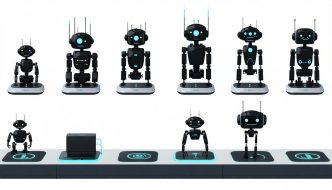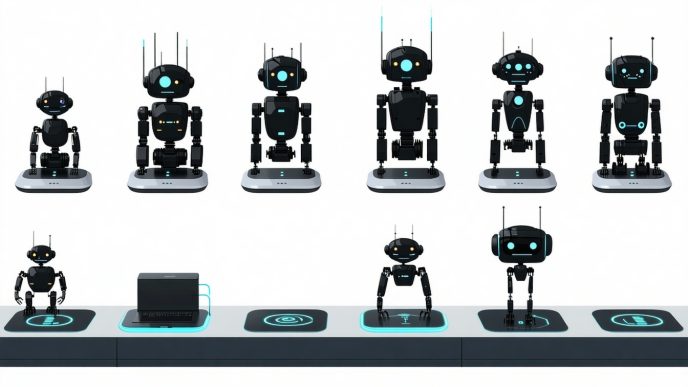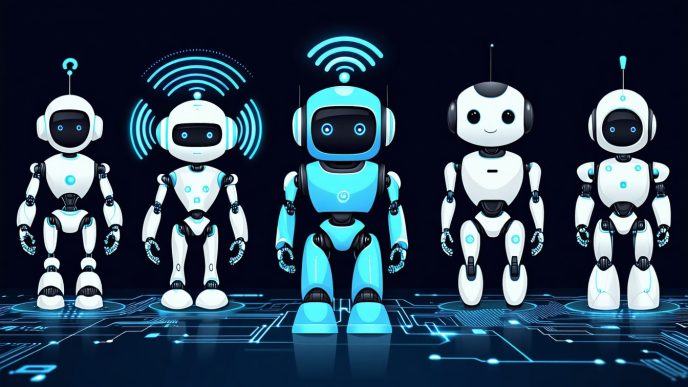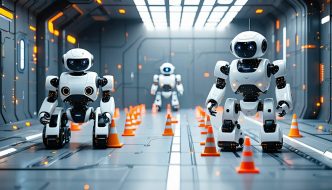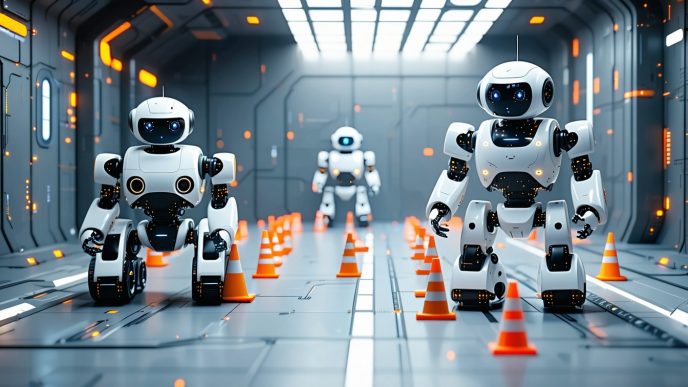Understanding AI-Driven Robots
Artificial intelligence (AI) has transformed the landscape of robotics, enabling machines to perform tasks that were previously considered too complex for automation. This section will highlight the importance of AI in robotics and its profound impact on real-time decision making.
Importance of AI in Robotics
AI plays a pivotal role in enhancing the capabilities of robots. By integrating machine learning algorithms, AI allows robots to learn from their environments and experiences. This results in improved performance and adaptability across various tasks, from manufacturing to service industries. Some of the key benefits of AI in robotics include:
- Autonomy: AI-driven robots can operate independently, making decisions based on real-time data.
- Efficiency: These robots optimize processes, reducing time and resource consumption.
- Accuracy: AI enhances precision in tasks such as assembly, inspection, and data analysis.
| Feature | Benefit |
|---|---|
| Autonomy | Operate without human intervention |
| Process Optimization | Faster operations |
| Precision | Higher accuracy in task execution |
The integration of AI not only allows robots to execute predefined tasks but also empowers them to adapt to dynamic conditions and learn from their interactions.
Impact of AI on Real-Time Decision Making
The ability of robots to make decisions in real-time is largely influenced by their AI capabilities. AI algorithms process vast amounts of data swiftly, enabling robots to evaluate options and choose the best actions based on various parameters. This feature is essential for applications requiring timely responses, such as:
- Obstacle Avoidance: Robots can identify and react to obstacles in their path to navigate safely. For more details, see best robot for obstacle avoidance.
- Grasping and Manipulation: AI improves a robot’s ability to handle objects, enhancing its adaptability in environments like warehouses. Refer to our article on the best robot for grasping and manipulation.
- Navigation and Mapping: AI aids robots in mapping their environments and efficiently reaching destinations. For further information, visit the best robot for navigation and mapping.
A table showcasing the capabilities influenced by AI in real-time decision making is provided below:
| Capability | Description |
|---|---|
| Object Recognition | Identifying and responding to different items |
| Route Optimization | Determining the most efficient travel path |
| Task Scheduling | Prioritizing tasks based on urgency and importance |
AI-powered robots are reshaping industries by providing timely, smart solutions. As the technology continues to evolve, the quest for the best robot for AI decision making remains central to advancements in automation and robotics.
Feature Comparison: Gripping Ability
In the realm of robotics, gripping ability is a crucial feature, particularly for applications that involve manipulation of objects. Assessing how well a robot can grasp and handle various items can significantly impact its overall functionality and effectiveness.
Defining Gripping Ability in Robots
Gripping ability refers to a robot’s capacity to secure, hold, and manipulate objects. This involves various mechanisms and technologies that contribute to how effectively robots can perform tasks that require dexterity and precision. Gripping mechanisms can vary widely, from simple mechanical claws to advanced adaptive grippers that adjust to the shape and weight of different objects.
Factors such as the design of the gripper, the materials used, and the control system implemented can all influence the gripping capabilities of a robot. For example, high-torque motors can provide the necessary force required to lift heavier items, while sensors can enhance the robot’s awareness of the object being gripped to optimize the gripping process.
Factors Affecting Gripping Efficiency
Several factors can impact the efficiency of a robot’s gripping ability, including:
| Factor | Description |
|---|---|
| Gripper Design | The shape and configuration of the gripper determine how well it can conform to various objects. Adaptive grippers often outperform rigid ones. |
| Material Used | The composition of the gripper surfaces (e.g., rubber, silicone, metal) affects friction and grip strength. |
| Sensing Technology | The presence of tactile and proximity sensors improves a robot’s ability to assess and adapt to the object being handled. |
| Force Control | The ability to modulate grip force minimizes the risk of damaging delicate items and allows for secure handling of heavier ones. |
| Programming Algorithms | Advanced algorithms can optimize gripping strategies based on the specific tasks at hand and improve responsiveness to changing conditions. |
Understanding these factors is essential for determining the best robot for AI decision making, particularly when object manipulation and handling are prioritized. For further comparisons on specific features, readers may refer to our feature specific robot comparisons to find more detailed insights on robots tailored for gripping and manipulation challenges.
Feature Comparison: AI Intelligence
Levels of AI Intelligence in Robots
AI intelligence in robots can be categorized into several distinct levels based on their capability to process information, learn from experiences, and make decisions. These levels range from basic programmable logic to sophisticated adaptive learning systems.
| Level of AI Intelligence | Description | Example Application |
|---|---|---|
| Reactive Machines | Responds to specific stimuli without learning | Basic automated systems |
| Limited Memory | Uses past experiences to inform current decisions | Navigation systems that adapt to surroundings |
| Theory of Mind | Understands emotions and beliefs in others | Social robots designed for interaction |
| Self-Aware | Recognizes its own state and can adapt | Advanced robots capable of learning from user interactions |
Applications of AI in Real-Time Decision Making
AI technology is crucial in enabling robots to make swift decisions based on real-time data. This capability allows for enhanced performance across various tasks and environments. The following applications illustrate how AI is utilized for real-time decision-making in robots.
| Application | Description | Impact on Functionality |
|---|---|---|
| Obstacle Avoidance | Detects and navigates around barriers | Increases safety and efficiency |
| Task Automation | Executes tasks based on programmed parameters | Reduces manual labor and errors |
| Predictive Analytics | Analyzes data patterns for proactive decisions | Improves accuracy and response times |
| Voice Command Understanding | Responds to spoken instructions | Enhances user interaction and control |
Robots that excel in AI decision-making often integrate multiple levels of intelligence and applications, ensuring they are capable of adapting to dynamic environments. For further comparisons on various robot features, visit our section on feature specific robot comparisons.
Feature Comparison: Navigation Skill
Effective navigation is crucial for robots, particularly those employed in dynamic environments. This section explores the navigational techniques utilized by robots and how these capabilities can be enhanced for better performance.
Navigational Techniques in Robots
Robots employ various navigational methods to traverse their surroundings effectively. Common techniques include:
- GPS Navigation: Utilizes Global Positioning System signals to determine the robot’s location. This method is particularly useful for outdoor navigation.
- Inertial Navigation: Combines data from accelerometers and gyroscopes to track the robot’s position and movement without external references.
- Vision-Based Navigation: Uses cameras and computer vision algorithms to analyze the environment in real-time, allowing the robot to identify objects and obstacles.
- Lidar Navigation: Employs laser sensors to create detailed maps of the surrounding area. This technology is beneficial for accurate obstacle detection and avoidance.
Here is a comparison of the efficiency of different navigational techniques based on performance metrics:
| Navigation Technique | Accuracy | Range | Environment Suitability |
|---|---|---|---|
| GPS Navigation | Moderate | Long | Outdoor |
| Inertial Navigation | High | Medium | Indoor/Outdoor |
| Vision-Based Navigation | High | Short | Indoor |
| Lidar Navigation | Very High | Medium | Indoor/Outdoor |
Enhancing Navigation Capabilities
Improving navigation skills in robots involves incorporating advanced technologies and techniques. Some effective strategies include:
- Sensor Fusion: Combining data from multiple sensors (e.g., GPS, cameras, Lidar) to create a more accurate representation of the environment. This approach increases the reliability of navigational data.
- Machine Learning Algorithms: Implementing algorithms that enable robots to learn from their environment and improve their navigation abilities over time. These algorithms can adapt to changing conditions and optimize paths.
- Simultaneous Localization and Mapping (SLAM): A technique that allows robots to build a map of an unknown environment while simultaneously keeping track of their location. This is particularly valuable in environments where GPS signals are weak or unavailable.
- Obstacle Avoidance Systems: Integrating real-time obstacle detection and avoidance methods helps robots navigate complex spaces safely.
For more detailed comparisons on specific features, explore our articles on best robot for navigation and mapping and best robot for obstacle avoidance. Understanding the navigation abilities of robots is essential for determining the best robot for AI decision making.
Feature Comparison: Battery Life
Significance of Battery Life in Robots
Battery life is a crucial factor in evaluating the overall performance of robots, especially those designed for real-time applications. A longer battery life allows robots to operate continuously without frequent recharging, making them more efficient and effective in completing tasks. In scenarios where robots must make quick, split-second decisions, having sufficient power to sustain operations is essential.
Robots with superior battery performance can perform in various environments without interruption, contributing to their reliability in tasks ranging from home security to industrial operations. Furthermore, robots with efficient energy use can be more environmentally friendly, reducing their carbon footprint.
Improving Battery Efficiency
Enhancing battery efficiency is key to maximizing the operational duration of robots. Various technologies and strategies can improve battery life. These may involve optimizing algorithms that manage power consumption, using energy-efficient components, or implementing advanced battery technologies.
| Improvement Method | Description | Potential Increase in Battery Life |
|---|---|---|
| Intelligent Power Management | Algorithms that adjust power use based on task demands | Up to 30% |
| Battery Technology Advancements | Use of lithium-sulfur or solid-state batteries | Up to 50% |
| Lightweight Materials | Using lighter materials in robot construction | Up to 15% |
| Energy Recovery Systems | Technology that recycles energy during operation | Up to 25% |
Selecting a robot with a focus on battery efficiency can dramatically impact performance, especially when looking for the best robot for AI decision making. For potential buyers comparing robots based on battery life, understanding these factors is essential. To explore further, refer to our article on the best robot for battery life for more insights.
Assessing the Best Robot for AI Decision Making
To find the best robot for AI decision making, it’s essential to have clear criteria for evaluation. With various features to consider, potential buyers can make informed choices based on important attributes that suit their needs.
Criteria for Evaluating AI-Driven Robots
When assessing robots, several criteria come into play. Each factor influences how effectively a robot can perform in real-world scenarios. The following attributes are key benchmarks for evaluation:
| Criteria | Description |
|---|---|
| Gripping Ability | Evaluates how well the robot can grasp and manipulate objects. For more details, see our article on best robot for grasping and manipulation. |
| AI Intelligence Level | Measures the sophistication of the AI algorithms and decision-making capabilities. |
| Navigation Skill | Analyzes the effectiveness of the robot’s movement through various environments. Check the best robot for navigation and mapping for further insights. |
| Battery Life | Assesses how long the robot operates before needing a recharge. More on this can be found in our article on the best robot for battery life. |
| Adaptability | Looks at how well the robot adjusts to changing conditions or tasks. |
| Interaction Capability | Evaluates the robot’s ability to understand and respond to user commands, including voice recognition. Learn about models in our best robot for voice command understanding. |
| Safety Features | Considers the safety mechanisms that protect users and surroundings from potential harm. |
Choosing the Right Robot for Your Needs
Selecting the most suitable robot depends on specific requirements and intended applications. Here are some common use-case scenarios that guide selection:
| Use-Case Scenario | Recommended Features |
|---|---|
| Home Security | Requires advanced navigation and obstacle avoidance. For more on this, refer to best robot for home security. |
| Assistance with Children or Pets | Needs excellent emotional interaction and adaptability. See best robot for child and pet interaction. |
| Elderly Care | Focuses on interaction capabilities and emotional support. Refer to best robot for elderly care assistance. |
| Navigation in Challenging Terrains | Best suited with high navigation skill for rugged landscapes, check out best robot for rough terrain mobility. |
| Speed and Agility | Requires high maneuverability and swift decision-making, see best robot for speed and agility. |
| Multi-Room Navigation | Requires advanced navigation techniques for seamless movement across different spaces. Consider best robot for multi-room navigation. |
| Wireless Charging | Enhances user convenience and operational longevity, learn more about best robot for wireless charging. |
Understanding the criteria and aligning them with personal or professional needs will help in identifying the best robot for AI decision making. Analysis of these features allows potential owners to ensure that they invest in a robot that truly enhances their operational efficiency and effectiveness.






